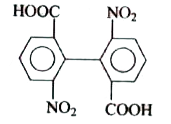Which of the following isomerism, exhibited by [CrCl2(OH)2(NH3)2]−?
Ionization
Linkage
Geometrical
Hydrate
The correct Answer is:C
To determine the type of isomerism exhibited by the coordination compound (CrCl2(OH)2(NH3)2)−, we will analyze the possible isomerisms step by step.
Step 1: Identify the Coordination Number and Geometry
The central metal ion in this compound is chromium (Cr), which typically has a coordination number of 6 in octahedral complexes. This means that there are six ligands surrounding the chromium ion.
Hint: Look for the coordination number based on the number of ligands attached to the central metal ion.
Step 2: List the Ligands
The ligands present in the compound are:
- 2 Chloride ions (Cl)
- 2 Hydroxide ions (OH)
- 2 Ammonia molecules (NH3)
Hint: Identify and categorize the ligands based on their nature (neutral, anionic, etc.).
Step 3: Determine Possible Isomerisms
We will consider the following types of isomerism:
- Ionization Isomerism: This occurs when a ligand can be exchanged with an anion outside the coordination sphere. In this case, there are no anions outside the coordination sphere that can lead to ionization isomerism.
- Linkage Isomerism: This occurs when a ligand can coordinate to the metal in more than one way. In this case, there are no ambidentate ligands present.
- Hydrate Isomerism: This occurs when water molecules are present in different forms (inside or outside the coordination sphere). There are no water molecules in this compound.
- Geometrical Isomerism: This occurs in octahedral complexes when ligands can be arranged differently around the central metal ion. We can have cis and trans forms.
Hint: Eliminate isomerism types that do not apply based on the ligands present and their arrangements.
Step 4: Analyze Geometrical Isomerism
In an octahedral complex with the given ligands:
- Cis Isomer: The two Cl ligands can be adjacent to each other, and the two OH or NH3 ligands can also be adjacent, creating different cis configurations.
- Trans Isomer: The two Cl ligands can be opposite each other, as can the two OH or NH3 ligands.
Hint: Visualize the arrangement of ligands in 3D to differentiate between cis and trans configurations.
Step 5: Determine Optical Isomerism
The cis isomers can be optically active if they are non-superimposable on their mirror images. In contrast, the trans isomers are usually not optically active because they can be superimposed on their mirror images.
Hint: Consider the symmetry of the isomers to determine if they can exist as optical isomers.
Conclusion
Based on the analysis:
- The compound (CrCl2(OH)2(NH3)2)− exhibits geometrical isomerism (cis and trans forms) due to the arrangement of the ligands around the central chromium ion.
Final Answer: The type of isomerism exhibited by (CrCl2(OH)2(NH3)2)− is geometrical isomerism.
The central metal ion in this compound is chromium (Cr), which typically has a coordination number of 6 in octahedral complexes. This means that there are six ligands surrounding the chromium ion.
The ligands present in the compound are:
- 2 Chloride ions (Cl)
- 2 Hydroxide ions (OH)
- 2 Ammonia molecules (NH3)
We will consider the following types of isomerism:
- Ionization Isomerism: This occurs when a ligand can be exchanged with an anion outside the coordination sphere. In this case, there are no anions outside the coordination sphere that can lead to ionization isomerism.
- Linkage Isomerism: This occurs when a ligand can coordinate to the metal in more than one way. In this case, there are no ambidentate ligands present.
In an octahedral complex with the given ligands:
- Cis Isomer: The two Cl ligands can be adjacent to each other, and the two OH or NH3 ligands can also be adjacent, creating different cis configurations.
- Trans Isomer: The two Cl ligands can be opposite each other, as can the two OH or NH3 ligands.
The cis isomers can be optically active if they are non-superimposable on their mirror images. In contrast, the trans isomers are usually not optically active because they can be superimposed on their mirror images.
Based on the analysis:
- The compound (CrCl2(OH)2(NH3)2)− exhibits geometrical isomerism (cis and trans forms) due to the arrangement of the ligands around the central chromium ion.
Topper's Solved these Questions
- CO-ORDINATION COMPOUNDSBook:VK JAISWAL ENGLISHChapter:CO-ORDINATION COMPOUNDSExercise:LEVEL 3 (PASSAGE TYPE)
Explore 98 Videos
- CO-ORDINATION COMPOUNDSBook:VK JAISWAL ENGLISHChapter:CO-ORDINATION COMPOUNDSExercise:ONE OR MORE ANSWERS IS/ARE CORRECT
Explore 71 Videos
- CHEMICAL BONDING (BASIC)Book:VK JAISWAL ENGLISHChapter:CHEMICAL BONDING (BASIC)Exercise:SUBJECTIVE PROBLEMS
Explore 54 Videos
- d-BLOCK ELEMENTSBook:VK JAISWAL ENGLISHChapter:d-BLOCK ELEMENTSExercise:ASSERTION-REASON TYPE QUESTIONS
Explore 32 Videos
Similar Questions
Consider the following isomerism:
(i) Ionization
(ii) Hydrate
(iii) Coordination
(iv) Geometrical
(v) Optical
Which of the above isomerism are exhibited by [Cr(NH3)2(O)2Cl2]−?
View SolutionConsider the following isomerism:
(i) Ionization
(ii) Hydrate
(iii) Coordination
(iv) Geometrical
(v) Optical
Which of the above isomerism are exhibited by [Cr(NH3)2(O)2Cl2]−?
View Solution
Knowledge Check
Which of the following compounds exhibit optical isomerism?
A BH2C=C=CH2C
BH2C=C=CH2C D
D
Complex compounds that have the same molecular formula but have different structural/space arrangements of ligands around central metal atom/ion are called isomers, these are of two types namely structural and stereoisomers.
Q. Type of isomerism exhibited by [CrCl2(NO)2)2(NH3)2]− complex ion are:
View SolutionIsoomerisms exhibited by [Cr(NH3)2(H2O)2Cl2]+ are
View SolutionWhich of the following isomerism is/are shown by the complex [CoCl2(H2O)2(NH3)2] Br ?
View SolutionWhich of the following statement is true about the complex [CrCl3(OH)2(NH3)]2− ion?
View SolutionWhich of the following isomerism is/are not shown by the complex [Co(Cl2(OH)2(NH3)2]Br?
View SolutionChoose the correct code regarding, possible number of geometrical isomers exhibited by following complexes:
(I) [CrCl2(NO2)2(NH3)2]−
(II) [Co(NO2)3(NH3)3]
(III) [PtCl(NO2)(NH3)(py)]
(IV) [PtBrCl(en)]
View SolutionWhich one amongst of the following isomerism is shown by [Pt(NH3)2Cl2]?
View Solution